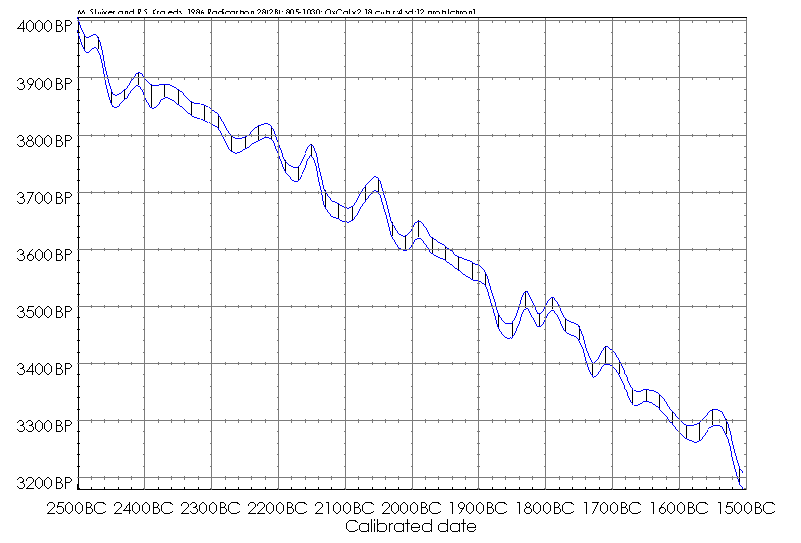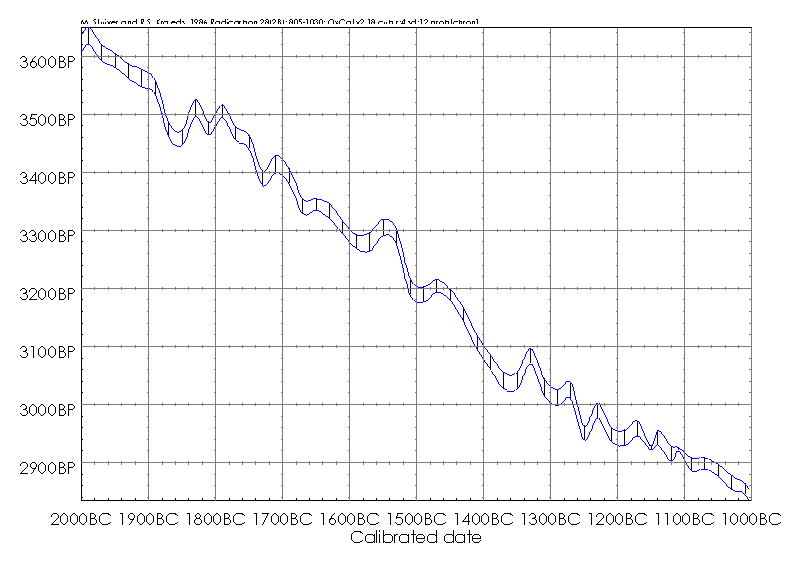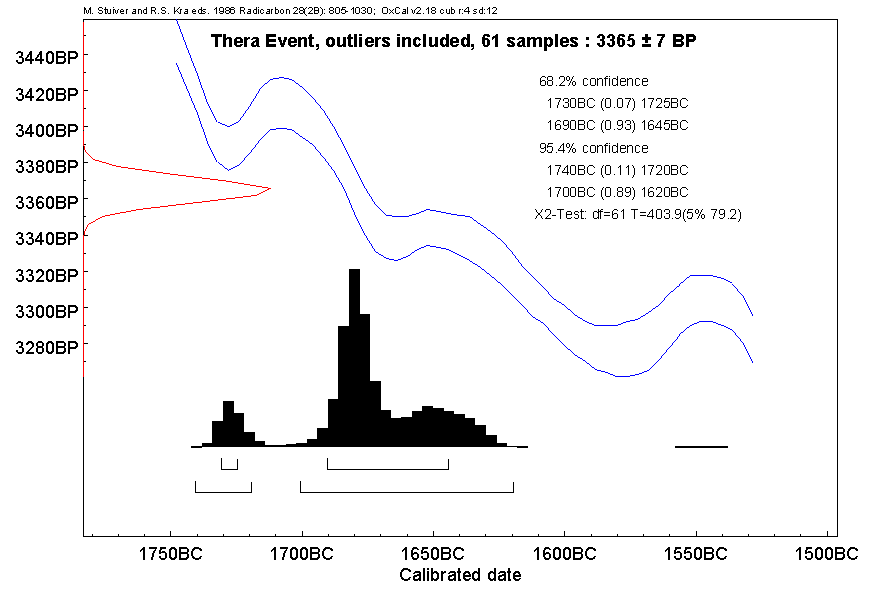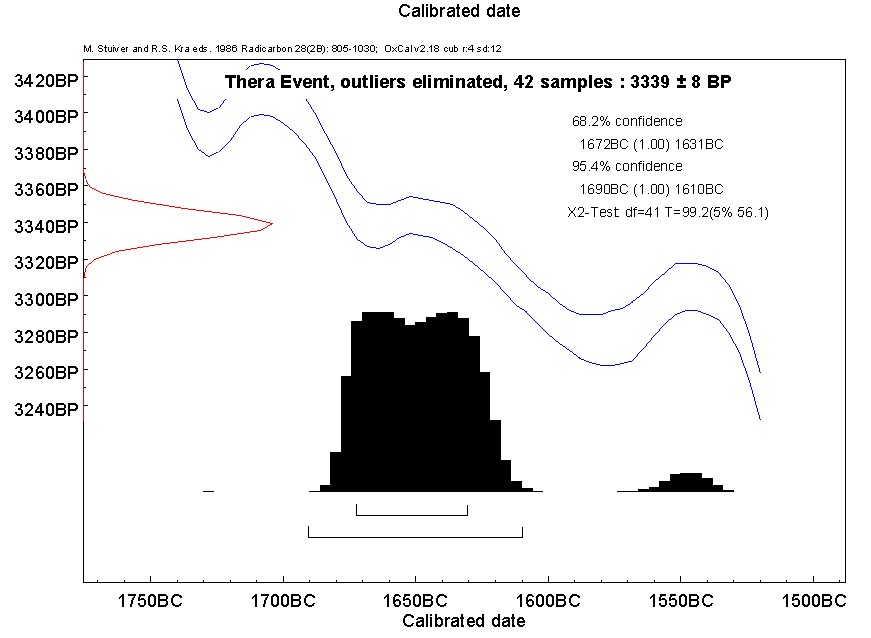Status of Synchronisation
of East Mediterranean Civilizations
The main
problem of synchronisation is absolute dating, which is necessary to put the
many existing links between civilizations of this period into an absolute time frame.
In the current project however, these links should be evaluated on a more
common basis. However, there are conflicting results concerning absolute dates
depending on the methods used by the humanities and natural sciences,
respectively.
The focus
of interest is the dating of the volcanic eruption of Thera.
Archaeologists date this event, which was the main reason for the loss of the
hegemony of the Minoan culture, to be within the 16th/15th
century BC, although there are different opinions. Warren and Cadogan date the eruption between 1550 and 1480 BC (Myers et al, 1992), Driessen and McDonald between 1550 and 1530 BC (Driessen
á, McDonald, 1995 ).
On
the other hand, natural science dates this event to the 17th
century using an increasing number of new methods. In addition, ice core
examinations resulted in a date of 1645 ▒ 20 BC (Hammer et al, 1987).
Dendrochronology, through the investigation of frost rings in trees as records
of major volcanic eruptions (LaMarche Jr. et al, 1984), dates the eruption of
Thera to 1628 BC. 14C dates also cluster towards such an early date.
Table 1 presents all 14C dates available, which are in connection
with the Thera event. Figure 6a presents the combined calibration of 61 samples
and figure 2b 42 14C dates after the elimination of outliers, from
the destruction layer of Akrotiri. Although the c2-Test
shows, that not all the dates come from one event only, the time span for 1-ˇ lies between 1672 and 1631 BC,
the 2-ˇ between 1690 and 1610
BC. Thus 14C dating strongly confirms the dendrochronological, but
also the ice core date. Through the tree-ring calibration of 14C
dates (figure 1), however, one should realize that dendrochronology and
radiocarbon dating are not entirely independent methods. Some archaeologists
have accepted this date and integrated into their chronology (Niemeier, 1995,
and Betancourt, 1987).
The
main criticism against the early dates is the reliability of dendrochronology,
which is based on trees grown in North America, Germany and Ireland, for dating
in the Eastern Mediterranean (Rohl, 1996).
Recently there also seems to be a verification by the dendrochronology
developed on Anatolian trees, exactly matching the other dendrochronologies (Kuniholm, 1996).
The most important finding are some tree ring samples from Porsuk, only 840 km
east of Thera. These samples have been combined with others to form a floating
sequence of 1503 years, absolutely dated by parallelisation with other
dendrochronologies from 2220-718 BC. Ring number 854 shows a real big anomaly.
It is not a frost ring, but a ring with rather enhanced growth, but this
can be explained geographically. When in North America the Thera ash cloud
produced a significant frost, in Anatolia it resulted in heavy rain falls. This
ring 854 must be from the year 1628 BC. Wiggle matching from 18 samples from
different parts of this dendrochronology date this ring 854 to 1641+76 -22 BC.
For
this project is of importance that Bietak (Bietak, 1995)
discovered in Lower Egypt in the Hyksos settlement from Tell el┤Daba pumice
presumably deriving from the great eruption at Thera. Recently, the advocates
of the conventional (lower) chronology are encouraged by the discovery of this
pumice in strata which follow those of the late Hyksos palace recently
unearthed at this site. Deposits associated with that palace contained fragments
of fresco paintings of Minoan character closely resembling some of those found
in Thera and dating from the period there immediately before the great
eruption. From stratigraphical evidence these layers can be dated earliest to
the beginning of the 18th dynasty, which means a date of about 1550
BC according to the Cambridge Ancient History Record (CAHR).


Figure
1 Sections of the tree-ring calibration curve
relating a measured radiocarbon age to a calibrated date, relevant for the
second millennium BC. (a) shows the range from 2500 to 1500 BC and (b) from
2000 to 1000 BC. The curves were generated from the 14C calibration
program available from Oxford (Bronk Ramsey 1995), which is particularly versatile and easy to
handle. The band width indicates the 1-s uncertainty in the
calibration curve. Although there are only small "wiggles" in the
curve, there are obviously sections where even a precise 14C/12C
ratio measurement will lead to relatively large uncertainty in the calibrated
age.

Fig.2a

Fig.2b
Figure
2 Combined Calibration for dates from the Akrotiri destruction layer, before (a)
and after (b) elimination of outliers.
Although
the c2 test fails in both cases,
thus underlining that not all dates come from one event only, the following
results are obtained: In case (a) 61 samples give a mean of 3365 ▒ 7 BP. By calibration two intervalls are
received for the 1-s confidence
intervall (that means with 68,2 % confidence), the first from 1730 to 1725 BC
(with only 7% probability) and the second from 1690 to 1645 (with 93%
probability). In case (b) 42 samples give a mean of 3339 ▒ 8 BP. That gives calibrated only one
intervall for the 1-s confidence from
1672 to 1631 BC and one intervall for the 2-s
confidence from 1690 to 1610. The little peak on the right side near 1550 BC
lies outsides the 2-s intervall and is
thus smaller than 5% of the whole distribution. That is why this peak is
neglected by the calibration.
The
problems arising with discrepancies in dating of the Thera eruption are closely
linked with Egyptian chronology, and with the CAHR. There are three floating
relative chronologies with absolute duration, one for the Old Kingdom, the
Middle Kingdom and the New Kingdom. For each of them the list of kings with the
time span of their rule is known. What is not known from the record is the
absolute beginning and the duration of the intermediate times. As shown
extensively by Woelfli (Woelfli, 1994,
especially with his fig.10) calibrated 14C dates from the Old
Kingdom are on the average 375 years older than after CAHR.
Many
of the 14C dates from Egypt seem to have problems. Therefore, one of
the main goals of this project is to repeat many datings with AMS under special
precautions for the sample selection.
Selection
of Samples
Among
a variety of selection criteria for samples, two are particularly important:
First, the samples should have a good archaeological context, which means that
their position in the context should be known and the stratigraphy should be
clear. Second, these strata or contexts should also contain well-defined and
archaeologically datable remains.
Selection
by Time
Because
of the shape of the calibration curve not all segments are equally well suited
for 14C dating. To show the problems in figure 2a and 2b two
overlapping sections of the calibration curve are presented. The first ranges
from 2500-1500 and the second from 2000-1000 BC.
Samples
will only be taken from archaeological contexts belonging to "secure"
segments of the calibration curve, where it runs reasonably steep and
unambiguous. At that time, the new VERA AMS system should be ready for high
precision (<0.5%) measurements. Multiple measurements of samples from
"secure" sectors of the calibration curve should be carried out, thus
reducing the uncertainty of the dates to a minimum.
The
following time segments in the first half of the second millenium BC are for
example at our disposal for high precision measurements: from 1960 - 1880, 1680
- 1620 and 1460 - 1400 BC.
In
addition, if several radiocarbon ages are measured for a particular time
period, "wiggle matching" to the corresponding section of the
calibration curve may also lead to an absolute age assignment, if good relative
chronologies are supplied. Thus also samples could be dated if they do not fall
into the secure parts of the calibration curve.
Selection
by Material
With
charcoal there is in general the old wood problem. It may originate from wood
which was already old when it was burnt, and thus deliver results which are too
old. So we want in this project only - as far as available - concentrate on the
dating of short-lived samples, such as burnt seeds or similar material. In
contexts, which can be very well dated relatively or absolutely as in Egypt it
is necessary to do so.
It
will also be possible to consider dating of bones within this project, assuming
that VERA has gained enough experience with bone dating, when this project
comes into effect. Best results will be derived by using bones from short lived
animals.
Collection
of Samples
The
Collection of samples from Egypt and different regions of the Aegean will be
done by various collaborators of the project.
Ein eigenes Projekt zu diesem Thema findet man hier:
Literature
Letzte
Bearbeitung
31.10.2011



